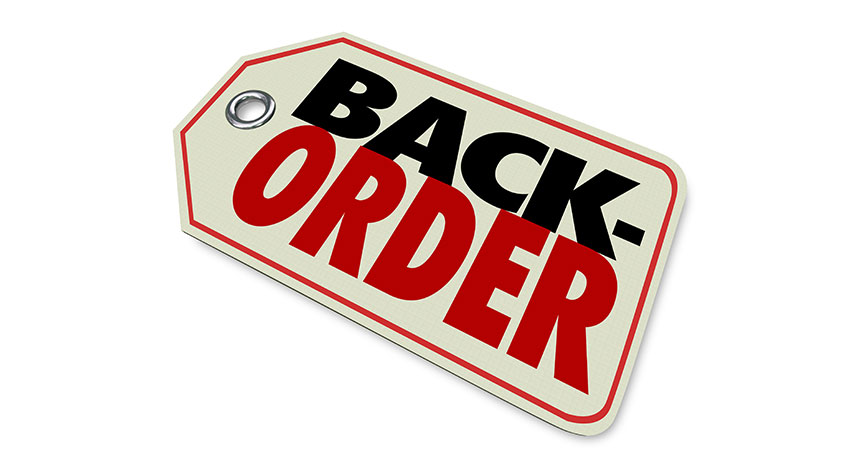An order is not a sale that you can take to the bank until the item is shipped or picked up at the store and the transaction is invoiced and funds are deposited.
The rate of ecommerce backorders is an excellent measure of your inventory management and customer service. A much better measure is the initial customer order fill rate discussed below.
Backorders generally only occur on your better-selling items. Out of stock and backorders can cost companies 10% or more in lost sales. When merchants analyze their numbers on bestsellers, they realized how much more they could have sold with more in stock and hopefully plan purchases better in the future.
If your ecommerce business is also a wholesaler to Amazon, Walmart and other large retailers, they’ll drop your product line if you don’t consistently hit agreed-upon delivery dates. Not meeting their vendor compliance policies will also mean paying chargebacks for late delivery.
For ecommerce and omnichannel retailing, there are substantial penalties for not adhering to the Federal Trade Commission’s 1975 Mail, Internet or Telephone Order Merchandise Rule, amended in 2014. Developing these customer-oriented policies as FAQs on your website is a best practice.
Ecommerce and omnichannel customers are very opportunistic. As they comparison shop and check your offerings, chances are you’ll never get the order if the item is out of stock.
Our studies have shown that ecommerce backorders can cost you $15 to $20 each, eroding profits. This includes customer service calls; fulfillment labor, shipping and packing material costs. Also, backordered items often have a higher return rate. There may be costs for expedited shipping and upgrading customer outbound shipments at your cost.
The biggest backorder cost may be losing customers and their lifetime value.
Practical Solutions
Inventory is among the largest balance sheet assets in most companies. You can’t be in stock on every item, all the time, without destroying your inventory turn and carrying costs. Here are 8 practical solutions to reduce backorders and stockouts:
Understand how merchandise statistics affect profitability
Analyzing the cost of being out of stock and figuring out how to optimize inventory levels should be a strategic objective of every company. This previous blog lists 6 key inventory metrics you should report.
As illustrated above, determine the impact of backorders and stockouts in direct costs, lost sales and potential customer loss. This should be an early-study task.
Identify reasons for out of stock and backorders
Analyze your stockouts and backorders by product, SKU and purchase order and determine why they occurred. Common reasons include:
- No reliable sales history to base plans or projections on: Fashion items or new items fall into this category.
- Lead time and reorderability: Buyers often have to estimate and take a risk on how many units they can sell in a season. There may be limited quantities and no ability to reorder from the vendor.
- Proprietary product: Known for long lead times and often high quantities purchased with limited reorderability in season.
- Late delivery from vendor: It happens even though they committed to the delivery date.
- Items appear in more promotions than originally planned. Purchase orders are placed months or even a year in advance and the quantities ordered are insufficient.
There are three other contributing factors which make companies less nimble.
- Companies often use massive spreadsheets to compensate for inadequate internal systems that project reorders and integrate with purchasing systems.
- Processes should be streamlined to identify products for reordering, purchase order approvals and electronic communication to vendors through EDI and other systems.
- Inventory control departments are often understaffed, considering the number of products, SKUs and the many promotions supported.
Include all stakeholders
Merchants, inventory control, fulfillment and finance are all inventory stakeholders. Give each a say in setting objectives and evaluation. Start by reviewing key inventory objectives and what they’re telling you about your business.
Perform a freight audit
Review your supply chain and determine where costs and time can be reduced. From an inbound freight perspective, any necessary changes in transportation to expedite purchase orders add enormous cost.
Vendor relations and purchase orders
Call center and website customer inquiries and FTC processing all are affected by the expected receipt date on purchase orders being maintained by merchants in a timely fashion. Is this a problem?
Streamline the business processes
Evaluate your inventory practices, document all inventory planning, purchasing, inventory control, inventory projection and overstock liquidation processes. How can these be improved?
Improve inventory needs projections
Here several major systems objectives which can improve backorder and out of stock conditions:
- Develop analysis and reporting to aid the rebuying analysis and decisions. Example: exception reporting of products that are potentially under and over stocked by product and SKU.
- Develop time-phased item forecasting which takes into account the product sales by fulfillment center location and in multiple promotions, comparing them to inventory on hand and vendor on order. How many weeks in the future will the stockout occur? How many weeks is the vendor lead time by item for back in stock?
Report initial customer order fill rates weekly
Management should have the initial customer order fill rate as part of their weekly reporting. The initial customer order fill rate is the percent of orders shipped complete without any backorders. This is better than the backorder rate because it gives an indication of how many customers are affected over time. Show this not just for the week but by category for a rolling 12 months. Generally, there is no backorder history in inventory systems.
Improved inventory management and reducing costly backorders should be a strategic objective of every ecommerce company because of the broad implications for profitability and the customer experience. As product offerings become much larger and digital marketing more complex, it’s imperative to have effective inventory processes, best practices and up-to-date systems in place.
Brian Barry is president of F. Curtis Barry & Company

